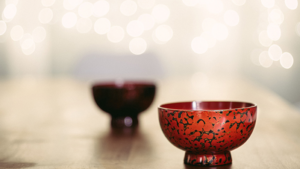Noble be the material, helpful and good
Arts and crafts and plastic –
Freely according to the opening words of Goethe’s poem “The Divine,” natural varnish and plastic are also about striving for perfection and the truly useful. Both materials embody this, with both identical and completely different properties.
What both materials have in common is that they are used to produce lightweight, stable and impermeable beverage containers. However, while the traditional handicraft products made of Japanese lacquer called “Urushi” were aimed at an elite, plastic developed into the epitome of the inexpensively available item for everyone.
There are now 600 years between the heyday of Urushi and the triumph of plastic. And around 10,000 kilometers as the crow flies when it comes to their origins. What the two materials have in common is their robust nature. At the same time, however, in addition to their temporal and geographical distance, they differ above all in social terms.
Urushi: A kind of exclusive precursor of plastic

The term “Urushi” originates from Asia and refers both to the lacquer from the tree of the same name and to its processing into practical as well as artistic objects, including cups and bowls. Made famous primarily by Japanese artists, the material lends stability, density and durability to basic products such as wood – characteristics that correspond to today’s plastic.
However, products made of Urushi are extremely cost-intensive due to the complex manufacturing process and were therefore only accessible to a small, affluent clientele during the craft’s heyday in the 14th to 17th centuries. The practical objects were treated like pieces of jewelry and passed down from generation to generation. Even today, Urushi embodies the pursuit of perfection and is regarded beyond the Asian region as a symbol of luxury.
PET: Material of modernity and mass supply
In the 1940s, the chemist John Rex Whinfield from Great Britain invented the plastic PET. After the Second World War, the success story of the flexible material began. Not without reason: It was the time of economic awakening, in which all sections of society were to participate. This required affordable mass-produced products, which helped the versatile and inexpensive-to-produce plastic to achieve a breakthrough. In the meantime, more than 500,000 tons of PET are produced each year in Germany alone. Including around 453,000 metric tons of PET bottles, which corresponds to about 6.2 billion 1-liter bottles.
Beverages in plastic: Good for people and nature
PET plastic bottles now form an integral part of our lives, while Urushi containers are mostly only used in museums or by enthusiasts. PET bottles are also of social importance on a global scale: lightweight, unbreakable, and with low manufacturing costs, they offer poorer sections of the population in structurally weak regions in particular an important basis for food supply.
Plastic bottles also score points in terms of ecology: PET can be 100 percent recycled into new products or used thermally as a source of energy. In addition, PET bottles save greenhouse gases during transport thanks to their low weight compared to heavy glass bottles. This also applies to production: while PET can be formed at around 260 degrees Celsius, glass requires heat of up to 1,600 degrees Celsius.
So if you want to enjoy your drink cheaply and sustainably, it’s best to drink water from a PET bottle. For an elite experience with an Urushi cup.
About „Plastic is fantastic“

„Plastic is fantastic” is about the relationship between man and one of the most elementary building blocks of civilization: plastic. The initiative aims to use factual contributions to achieve the appreciation that is appropriate for this versatile material.
The Austrian specialist for plastic packaging Alpla has launched “Plastic is fantastic” – because the company believes in the recyclable material. Thus, Alpla is already committed to sustainable recycling solutions in the third generation and is also a pioneer in the development of new bioplastics.

